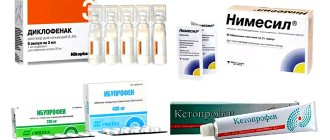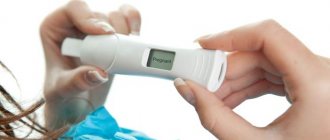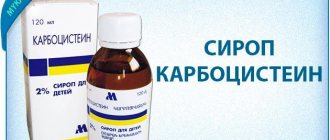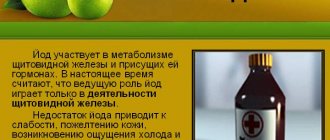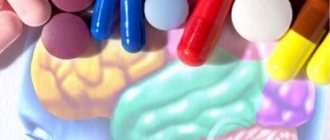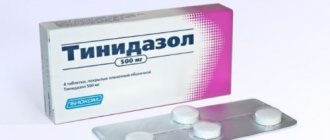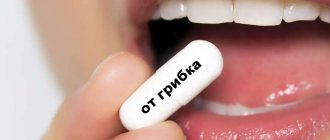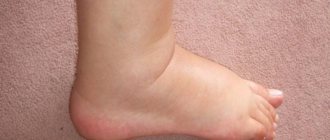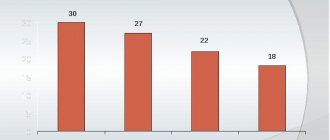Rheumatic diseases are almost always accompanied by an inflammatory process, which significantly reduces the patient’s quality of life. That is why, in case of joint pathologies, doctors attach great importance to the treatment of inflammation.
Several groups of drugs have an anti-inflammatory effect:
- NSAIDs – non-steroidal anti-inflammatory drugs.
- Chondoprotectors – active ingredients chondroitin and glucosamine.
- Glucocorticoids - usually prescribed in combination with other drugs, used for local or systemic use.
Operating principle
Soreness, inflammation and fever are common pathological conditions that accompany many diseases. If we consider the pathological course at the molecular level, we can see that the body “forces” the affected tissues to produce biologically active substances - prostaglandins, which, acting on blood vessels and nerve fibers, cause local swelling, redness and soreness.
In addition, these hormone-like substances, reaching the cerebral cortex, affect the center responsible for thermoregulation. Thus, impulses are sent about the presence of an inflammatory process in tissues or organs, so a corresponding reaction occurs in the form of fever.
A group of enzymes called cyclooxygenases (COX) are responsible for triggering the mechanism for the appearance of these prostaglandins . The main effect of non-steroidal drugs is to block these enzymes, which in turn leads to inhibition of the production of prostaglandins, which increase the sensitivity of nociceptive receptors responsible for pain. Consequently, painful sensations that bring a person suffering and unpleasant sensations are relieved.
Reminder when using NSAIDs at home
- Select an effective dosage, starting with a small one and if there is no effect, gradually increase.
- Treatment begins with high doses, decreases after inflammation decreases and is maintained until complete withdrawal.
- You cannot extend the treatment period on your own.
- Take the medicine during or after meals with a glass of water.
- The interval between taking other drugs is at least 4 hours.
- To avoid problems during the treatment period, give up alcohol and drink NSAIDs under the guise of a proton pump inhibitor.
Stop taking it immediately and consult a doctor in cases of negative symptoms: difficulty breathing, shortness of breath, chest pain, increased blood pressure, swelling in the arms and legs. The occurrence of itching, urticaria, yellowness of the skin and eyes. Abdominal pain, weakness, nausea, vomiting blood and urine, black stools.
NSAIDs should not be taken during pregnancy.
Types by mechanism of action
NSAIDs are classified according to their chemical structure or mechanism of action. Long-known drugs of this group were divided into types according to their chemical structure or origin, since at that time their mechanism of action was still unknown. Modern NSAIDs, on the contrary, are usually classified according to the principle of action - depending on what type of enzymes they act on.
There are three types of cyclooxygenase enzymes – COX-1, COX-2 and the controversial COX-3. At the same time, non-steroidal anti-inflammatory drugs, depending on the type, affect the main two of them. Based on this, NSAIDs are divided into groups:
- non-selective inhibitors (blockers) of COX-1 and COX-2 - affect both types of enzymes at once. These drugs block COX-1 enzymes, which, unlike COX-2, are constantly present in our body, performing various important functions. Therefore, exposure to them may be accompanied by various side effects, and a particular negative effect is on the gastrointestinal tract. This includes most classic NSAIDs.
- selective COX-2 inhibitors . This group affects only enzymes that appear in the presence of certain pathological processes, such as inflammation. Taking such drugs is considered safer and preferable. They do not have such a negative effect on the gastrointestinal tract, but at the same time the load on the cardiovascular system is greater (they can increase blood pressure).
- selective NSAIDs COX-1 inhibitors . This group is small, since almost all drugs that affect COX-1 also affect COX-2 to varying degrees. An example is acetylsalicylic acid in a small dosage.
In addition, there are controversial COX-3 enzymes, the presence of which has only been confirmed in animals, and they are also sometimes classified as COX-1. It is believed that their production is slightly slowed down by paracetamol.
In addition to reducing fever and eliminating pain, certain NSAIDs are also recommended for blood viscosity. The drugs increase the liquid part (plasma) and reduce the formed elements, including lipids that form cholesterol plaques. Due to these properties, NSAIDs are prescribed for many diseases of the heart and blood vessels.
How are non-steroidal anti-inflammatory drugs treated?
NSAIDs have only three main therapeutic actions.
- Anti-inflammatory.
- Painkiller.
- Antipyretic.
The anti-inflammatory effect is achieved by narrowing the dilated walls of blood vessels, which reduces their permeability. Due to this, swelling and redness are reduced, and pain is reduced accordingly. The most popular and proven are Indomethacin, Piroxicam, Diclofenac. In fact, almost all NVSPs have anti-inflammatory activity. Although the instructions contain notes about a slight anti-inflammatory effect (Dexketoprofen, Paracetamol).
Ketorol and Dexketoprofen provide an analgesic or analgesic They are the strongest, they act like a drug - quickly. Therefore, in case of severe pain, doctors prescribe medications of this series for a short period of time.
The antipyretic or antipyretic effect of drugs reduces the pyrogenic effect in the hypothalamus of the central nervous system, where the thermoregulation center is located. Pyrogens are substances that cause an increase in temperature. Formed under the influence of viruses, fungi, and protozoa. Paracetamol, Ibuprofen, Aspirin work at high temperatures. Although you need to remember that a temperature of up to 380 is a protective reaction of the body, where it is not necessary to prescribe antipyretics.
Its antiplatelet or blood thinning effect is aimed at preventing the formation of blood clots. The well-known aspirin in the popular dose of ¼ tablet per day. Women start drinking during menopause and until the end of their lives, men in old age (after 55 or according to indications). The drugs are aimed at inhibiting COX-2 in platelets.
List of NSAIDs
Basic non-selective NSAIDs
Acid derivatives:
- acetylsalicylic acid (aspirin, diflunisal, salasate);
- arylpropionic acid (ibuprofen, flurbiprofen, naproxen, ketoprofen, tiaprofenic acid);
- arylacetic acid (diclofenac, fenclofenac, fentiazac);
- heteroarylacetic (ketorolac, amtolmetin);
- indole/indene acetic acid (indomethacin, sulindac);
- anthranilic acid (flufenamic acid, mefenamic acid);
- enolic acid, in particular oxicam (piroxicam, tenoxicam, meloxicam, lornoxicam);
- methanesulfonic acid (analgin).
Acetylsalicylic acid (aspirin) is the first known NSAID, discovered back in 1897 (all others appeared after the 1950s). In addition, this is the only drug that can irreversibly inhibit COX-1 and is also indicated to stop platelet aggregation. Such properties make it useful in the treatment of arterial thrombosis and for the prevention of cardiovascular complications.
Selective COX-2 inhibitors
- rofecoxib (Denebol, Vioxx discontinued in 2007)
- lumiracoxib (Prexige)
- parecoxib (Dynastat)
- etoricoxib (Arcosia)
- celecoxib (Celebrex).
Main indications, contraindications and side effects
Today, the list of NSAIDs is constantly expanding and new generation drugs are regularly arriving on pharmacy shelves that can simultaneously lower the temperature, relieve inflammation and pain in a short period of time. Thanks to its mild and gentle effect, the development of negative consequences in the form of allergic reactions, as well as damage to the gastrointestinal tract and urinary system is minimized.
Table. Non-steroidal anti-inflammatory drugs - indications
| Property of a medical product | Diseases, pathological condition of the body |
| Antipyretic | High temperature (above 38 degrees). |
| Anti-inflammatory | Diseases of the musculoskeletal system - arthritis, arthrosis, osteochondrosis, muscle inflammation (myositis), spondyloarthritis. This also includes myalgia (often appears after a bruise, sprain or injury to soft tissues). |
| Painkiller | The drugs are used for menstrual pain and headaches (migraines), and are widely used in gynecology, as well as for biliary and renal colic. |
| Antiplatelet agent | Cardiac and vascular disorders: coronary heart disease, atherosclerosis, heart failure, angina pectoris. In addition, they are often recommended for the prevention of stroke and heart attack. |
Nonsteroidal anti-inflammatory drugs have a number of contraindications that should be taken into account. The drugs are not recommended for treatment if the patient:
- peptic ulcer of the stomach and duodenum;
- kidney disease - limited intake is allowed;
- blood clotting disorder;
- the period of gestation and breastfeeding;
- Severe allergic reactions to medications in this group have previously been observed.
In some cases, a side effect may occur, as a result of which the composition of the blood changes ("fluidity" appears) and the walls of the stomach become inflamed.
The development of a negative result is explained by inhibition of the production of prostaglandins not only in the inflamed lesion, but also in other tissues and blood cells. In healthy organs, hormone-like substances play an important role. For example, prostaglandins protect the lining of the stomach from the aggressive effects of digestive juice on it. Consequently, taking NSAIDs contributes to the development of gastric and duodenal ulcers. If a person has these diseases and still takes “prohibited” drugs, then the course of the pathology may worsen, even to the point of perforation (breakthrough) of the defect.
Prostaglandins control blood clotting, so a lack of them can lead to bleeding. Diseases for which examinations should be carried out before prescribing a course of NVPS:
- hemocoagulation disorder;
- diseases of the liver, spleen and kidneys;
- Varicose veins;
- diseases of the cardiovascular system;
- autoimmune pathologies.
Side effects also include less dangerous conditions, such as nausea, vomiting, loss of appetite, loose stools, and bloating. Sometimes skin manifestations in the form of itching and small rashes are also recorded.
It all starts with damage to the cell membrane
You may not be interested in knowing interesting things, but you can’t live without them. Read :-).
Let's start in order.
All living things are made up of cells, and all processes occur at the cellular level. Cells have a protective shell - a membrane. It consists of three layers.
We will look at a layer of phospholipids - these are complex high-level lipid molecules that are an important protective part of the cell membrane.
Now imagine that the cell membranes are damaged. This can happen in any organ, muscle, bone, cartilage, skin, etc.
There are many reasons:
- Injury.
- Injury.
- Infection.
- Oncology.
- Degeneration is wear and tear from stress and old age.
- Autoimmune diseases.
- Heredity.
Phospholipid molecules leak through the destroyed shell. The body’s red button is triggered - immediately isolate the affected area and restore order. And the work begins - many reactions occur. The phospholipid molecule is broken down into pieces by several phospholipases (A1; A2; C; D), that is, catabolism occurs. Phospholipase-A2 releases arachidonic polyunsaturated fatty acid. Having become free, arachidonic acid goes to the synthesis of eicosanoids, to which the enzyme Cyclooxygenase, abbreviated as COX, reacts like a red rag. When they react, Prostaglandin is formed, which triggers a protective process in the form of inflammation of a certain area.
It's clear? This is the synthesis of prostaglandins 
It would seem that everything is fine, the lesion is isolated from healthy cells, why take non-steroidal anti-inflammatory drugs? Yes, everything is fine, only in the case when there are few prostaglandins, and if there are a lot of them, then pain occurs that should not be endured.
What happens during the inflammatory process?
Five main symptoms:
- Redness.
- Edema.
- Temperature increase.
- Pain.
- Violation of many functions - movement, nutrition, sleep, mood, etc.
These symptoms can last a long time, be strong, and poison life. Moreover, swelling can be visible - on the joints, and not visible when the spine hurts with pinched nerves, or bones break, for example with osteoporosis. This is where NVSP comes to the rescue.
Prostaglandins appear in large quantities under the action of Cyclooxygenase (COX). So we need to reduce them. The task of NVSP is to block COX, thereby stopping the massive production of Prostaglandins. As a result, all pathological symptoms decrease.
Application using the example of the main drugs of the NSAID group
Let's look at the most popular and effective medications.
| A drug | Route of administration (form of release) and dosage | Application note | |||||
| external | through the gastrointestinal tract | injection | |||||
| ointment | gel | pills | candles | IM injection | Intravenous administration | ||
| Diclofenac (Voltaren) | 1-3 times (2-4 grams per affected area) per day | 20-25 mg 2-3 times a day | 50-100 mg 1 time per day | 25-75 mg (2 ml) 2 times a day | — | The tablets should be taken without chewing, 30 minutes before meals, with plenty of water. | |
| Ibuprofen (Nurofen) | Strip 5-10 cm, rub 3 times a day | Gel strip (4-10 cm) 3 times a day | 1 tab. (200 ml) 3-4 times a day | For children from 3 to 24 months. (60 mg) 3-4 times a day | — | 2 ml 2-3 times a day | The drug is prescribed to children if their body weight exceeds 20 kg |
| Indomethacin | 4-5 cm of ointment 2-3 times a day | 3-4 times a day, (strip – 4-5 cm) | 100-125 mg 3 times a day | 25-50 mg 2-3 times a day | 30 mg – 1 ml solution 1-2 r. per day | 60 mg – 2 ml 1-2 times a day | During pregnancy, Indomethacin is used to reduce the tone of the uterus to prevent premature birth. |
| Ketoprofen | Strip 5 cm 3 times a day | 3-5 cm 2-3 times a day | 150-200 mg (1 tablet) 2-3 times a day | 100-160 mg (1 suppository) 2 times a day | 100 mg 1-2 times a day | Dissolve 100-200 mg in 100-500 ml saline solution | Most often, the drug is prescribed for pain in the musculoskeletal system. |
| Ketorolac | 1-2 cm of gel or ointment – 3-4 times a day | 10 mg 4 times a day | 100 mg (1 suppository) 1-2 times a day | 0.3-1 ml every 6 hours | 0.3-1 ml in a stream 4-6 times a day | Taking the drug may mask the signs of an acute infectious disease | |
| Lornoxicam (Xefocam) | — | — | 4 mg 2-3 times a day or 8 mg 2 times a day | — | Initial dose – 16 mg, maintenance dose – 8 mg – 2 times a day | The medication is used for moderate to severe pain syndrome | |
| Meloxicam (Amelotex) | — | 4 cm (2 grams) 2-3 times a day | 7.5-15 mg 1-2 times a day | 0.015 g 1-2 times a day | 10-15 mg 1-2 times a day | — | For renal failure, the permissible daily dose is 7.5 mg |
| Piroxicam | 2-4 cm 3-4 times a day | 10-30 mg 1 time per day | 20-40 mg 1-2 times a day | 1-2 ml 1 time per day | — | The maximum permissible daily dosage is 40 mg | |
| Celecoxib (Celebrex) | — | — | 200 mg 2 times a day | — | — | — | The drug is available only in the form of capsules coated with a coating that dissolves in the gastrointestinal tract |
| Aspirin (acetylsalicylic acid) | — | — | 0.5-1 gram, take no more than 4 hours and no more than 3 tablets per day | — | — | — | If you have previously had allergic reactions to Penicillin, then Aspirin should be prescribed with caution. |
| Analgin | — | — | 250-500 mg (0.5-1 tablet) 2-3 times a day | 250 - 500 mg (1-2 ml) 3 times a day | In some cases, Analgin may have drug incompatibility, so mixing it in a syringe with other medications is not recommended. It is also banned in some countries | ||
Attention! The tables indicate dosages for adults and adolescents whose body weight exceeds 50-50 kg. Many drugs are contraindicated for children under 12 years of age. In other cases, the dosage is selected individually, taking into account body weight and age.
What is prescribed to protect the stomach
To protect the mucous membrane of the digestive tract, proton pump inhibitors are prescribed - Omeprazole, at a dose of 20 mg. Its purpose is to reduce the secretion of hydrochloric acid. A decrease in the synthesis of prostaglandins leads to a slowdown in the formation of the protective barrier of the stomach. And then hydrochloric acid will corrode the mucous membrane and cause the formation of erosions and ulcers. And taking NSAIDs together with Omeprazole produces less hydrochloric acid, and the risk of corroding the gastrointestinal mucosa is reduced.
NSAID medications are prescribed under the protection of a proton pump inhibitor if:
- There were ulcers and gastritis in the history.
- The treatment complex contains glucocorticoids.
- Smokes or drinks.
- The patient has taken NSAIDs in high dosages more than once.
- A long course of treatment with NSAIDs was prescribed.
Recommendations for correct use
In order for the drug to work as quickly as possible and not cause harm to health, you should adhere to the well-known rules:
- Ointments and gels are applied to the painful area, then rubbed into the skin. Before putting on clothes, you should wait until it is completely absorbed. It is also not recommended to take water treatments for several hours after treatment.
- Tablets must be taken strictly as directed, without exceeding the daily allowance. If pain or inflammation is too severe, then you should inform your doctor about this so that another, stronger drug can be selected.
- Capsules should be washed down with plenty of water without removing the protective shell.
- Rectal suppositories work faster than tablets. Absorption of the active substance occurs through the intestines, so there is no negative or irritating effect on the walls of the stomach. If the drug is prescribed to a child, then the young patient should be placed on his left side, then carefully insert the suppository into the anus and squeeze the buttocks tightly. Make sure that the rectal medication does not come out for ten minutes.
- Intramuscular and intravenous injections are given only by a medical professional! Injections must be given in the manipulation room of a medical institution.
Although many non-steroidal anti-inflammatory drugs are available without a prescription or some pharmacies may not require one, you should always consult with your doctor before taking them. The fact is that the action of this group of medications is not aimed at treating the disease, at relieving pain and discomfort. Thus, the pathology begins to progress and stopping its development once identified is much more difficult than it would have been done before.
( 7 ratings, average: 4.57 out of 5)
List of ointments with NSAIDs
Currently, the list of drugs for topical use with NSAIDs (ointments, gels, creams) that are used for diseases of the musculoskeletal system is quite wide. Ointments with NSAIDs may not have the same names. Doctors at the Yusupov Hospital use only non-steroidal anti-inflammatory drugs registered in the Russian Federation.
All NSAIDs for topical use are divided into several groups according to the main active ingredient, which is part of combined or multicomponent preparations. Multicomponent local medicinal products based on diclofenac include:
- Voltaren Emulgel;
- diklovit;
- diklak;
- diclobene;
- Diclonate P gel;
- dicloran;
- diclofenac-Acri;
- Ortofena soot.
Doctors also prescribe combination drugs containing diclofenac: diclofenacol, dicloran plus. Ibuprofen is part of Nurofen gel and long-lasting cream with NSAIDs. Monocomponent drugs have been created based on indomethacin: indomethacin Sopharma ointment, Indomethacin-Acri. Ketoprofen is the main active ingredient of the following gels and ointments based on NSAIDs:
- artrosilene;
- quick gel;
- ketoprofen Vramed;
- ketonal;
- febrofida;
- fastuma;
- flexena.
The NSAID nimesulide is included in the Nise gel; piroxicam is the main active ingredient in the final gel.
